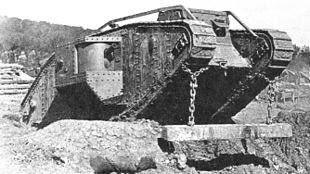
Back دبابة مارك الرابعة Arabic Mark IV BE-X-OLD Марк IV Bulgarian Mark IV (tenk) BS Tanc Mark Catalan Mark IV (tank) Czech Mark IV (kampvogn) Danish Mark IV (Panzer) German Mark IV Greek Mark IV (carro de combate) Spanish
| Mark IV | |
|---|---|
 Mark IV male with unditching beam deployed | |
| Type | Heavy tank |
| Place of origin | United Kingdom |
| Service history | |
| Used by | British Army Imperial German Army Reichswehr Imperial Japanese Army |
| Wars | First World War German Revolution of 1918–19 |
| Production history | |
| Designer | |
| Manufacturer | see text |
| Unit cost | about £5,000 [1] |
| Produced | May 1917 – end 1918 |
| No. built | 1,220 |
| Specifications | |
| Mass | 28
tons (28.4 tonnes) Female: 27 tons (27.4 tonnes) |
| Length | 26 ft 5 in (8.05 m) |
| Width | Male: 13 ft 6 in (4.12 m) |
| Crew | 8 |
| Armour | 0.5 inches (12 mm) |
Main armament | Male: Two 6-pounder (57-mm) 6 cwt QF guns with 332 rounds Female: five .303 Lewis guns |
Secondary armament | Male: Three .303 in Lewis guns |
| Engine | Daimler-Foster, 6-cylinder in-line sleeve valve 16 litre petrol engine 105 bhp at 1,000 rpm |
| Transmission | Primary: 2 Forward, 1 Reverse Secondary – 2 speed |
| Fuel capacity | 70 Imperial gallons |
Operational range | 35 mi (56 km) |
| Maximum speed | 4 mph (6.4 km/h) |
The Mark IV (pronounced Mark four) was a British tank of the First World War. Introduced in 1917, it benefited from significant developments of the Mark I tank (the intervening designs being small batches used for training). The main improvements were in armour, the re-siting of the fuel tank and ease of transport. A total of 1,220 Mk IV were built: 420 "Males", 595 "Females" and 205 Tank Tenders (unarmed vehicles used to carry supplies), which made it the most numerous British tank of the war. The Mark IV was first used in mid 1917 at the Battle of Messines Ridge. It remained in British service until the end of the war, and a small number served briefly with other combatants afterwards.
- ^ Glanfield, 2006, Appendix 3
© MMXXIII Rich X Search. We shall prevail. All rights reserved. Rich X Search